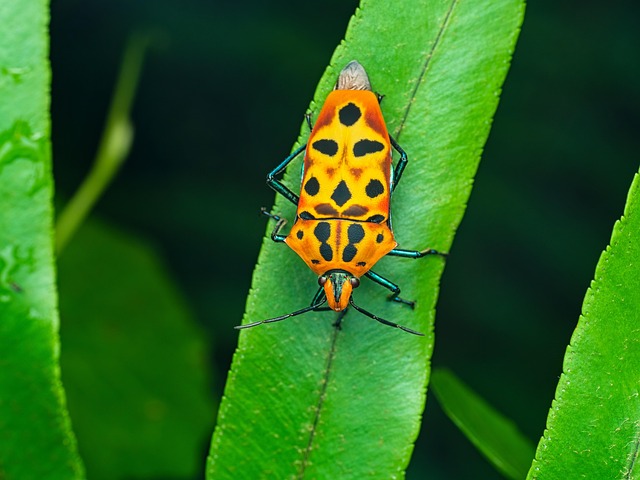Early detection is crucial for effective sowbug infestation treatment, targeting small, oval-shaped insects in damp, shaded areas. Symptoms include damage to stored products and honeydew leading to sooty mold. Understanding their life cycle helps develop strategies like sanitation, regular vacuuming, and targeted chemical treatments as a last resort. Consulting pest control experts for severe infestations ensures eco-friendly solutions. Prevention involves addressing moist environments, cleaning hard-to-reach areas, sealing gaps, improving ventilation, using sealants and traps to deter sowbugs without relying on chemicals.
Understanding the sowbug life cycle is key to effective pest control. This intricate cycle, comprising egg, nymph, and adult stages, allows these pests to thrive in various environments. Recognize infestations early by identifying signs like damage to fabrics, silk webs, and dead insect parts. Our guide delves into the life cycle, offers practical treatment methods, and shares preventive measures to help you combat sowbug infestations naturally. Discover how to identify and address these persistent invaders for a pest-free home or business with our comprehensive approach to sowbug infestation treatment.
Recognizing Sowbug Infestations: Signs and Symptoms
Recognizing a sowbug infestation is crucial for effective sowbug infestation treatment. One of the first signs to look out for is the presence of small, oval-shaped insects with a flat body and long antennae. These pests are often seen in clusters under rocks, logs, or leaf litter, as they prefer damp, shaded areas. Their eggs, usually laid in masses, can also indicate an infestation, especially when found in cracks and crevices of outdoor structures.
Symptoms of a sowbug invasion include damage to stored products like grains, seeds, and dried plants due to their feeding habits. They may also leave behind a sticky substance known as honeydew, produced by symbiotic bacteria living on their bodies, which can lead to the growth of sooty mold. As these insects multiply rapidly, especially in warm, humid conditions, prompt action is necessary for sowbug infestation treatment to prevent them from causing extensive damage to homes and gardens.
The Sowbug Life Cycle: Understanding Their Development
The sowbug, also known as a steel-colored or grain weevil, undergoes a distinct life cycle that comprises four stages: egg, larva, pupa, and adult. Female sowbugs lay their eggs in crevices, cracks, or under debris, typically in warm and humid environments. After hatching, the larvae emerge, characterized by their legless, cylindrical bodies and voracious appetites. They feed on organic matter, including stored grains, which makes them a significant pest in agricultural and household settings.
As the larvae grow, they molt several times before entering the pupal stage. During this phase, they transform internally, eventually emerging as adults with hardened exoskeletons and functional legs. Adult sowbugs are night-active and prefer dark, damp areas. Understanding their life cycle is crucial for effective sowbug infestation treatment, as it allows professionals to target each stage appropriately, disrupting their reproductive patterns and ensuring a more comprehensive pest control solution.
Effective Treatment Methods for Sowbug Infestations
Effective sowbug infestation treatment involves a multi-faceted approach due to their cryptic behavior and diverse food sources. Initial steps should include thorough inspections to identify breeding sites and active infestations. Sanitation is key; eliminating leaf litter, decaying plant material, and other organic debris reduces hiding places and food availability. Regular vacuuming can help remove adults and eggs from hard-to-reach areas.
Chemical treatments should be considered as a last resort due to the environmental impact and potential for pest resistance. Targeted insecticides applied by professionals can effectively disrupt sowbug populations. For severe or recurring infestations, consulting with a pest control expert is advisable. They can recommend eco-friendly solutions or develop a tailored plan incorporating regular monitoring, mechanical controls, and strategic applications of approved pesticides to manage and eradicate sowbugs successfully.
Preventive Measures: Stopping Sowbugs Before They Start
Preventing a sowbug infestation is key to maintaining a healthy home or business environment. Since sowbugs thrive in dark, moist areas, addressing these conditions can significantly deter their presence. Regularly vacuuming and cleaning hard-to-reach corners and crevices where they may hide can disrupt their early life stages. Sealing gaps and cracks around windows and doors prevents adult sowbugs from entering. Additionally, maintaining proper ventilation and reducing humidity levels makes living spaces less appealing to these pests.
Implementing preventive measures doesn’t only stop sowbugs but also saves on the cost and effort of treating an infestation later. Using sealants and traps as part of a proactive strategy can help detect and eliminate any early signs of sowbug activity, ensuring a pest-free environment for years to come. These steps are crucial in managing and controlling sowbug infestations effectively without resorting to chemical treatments.
Understanding the sowbug life cycle is key to effective pest control. By recognizing signs of an infestation, knowing their developmental stages, and employing appropriate treatment methods, homeowners can mitigate these pests. Additionally, implementing preventive measures can significantly reduce the risk of future sowbug infestations. Remember, early detection and proactive strategies are essential in the battle against sowbug infestation treatment.
